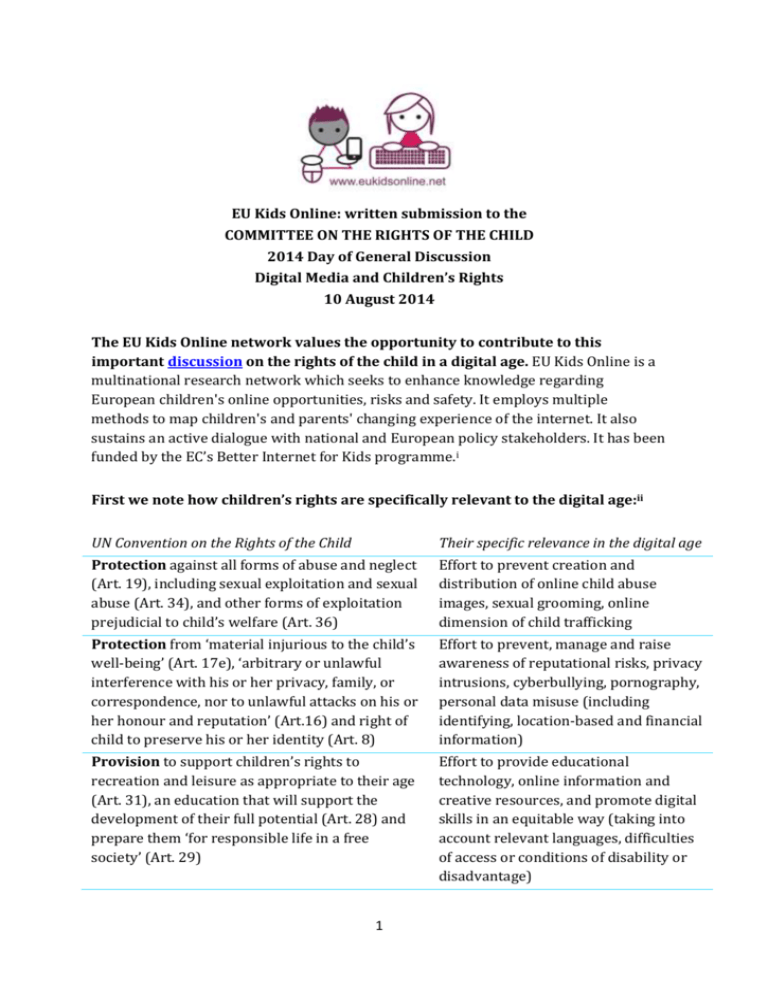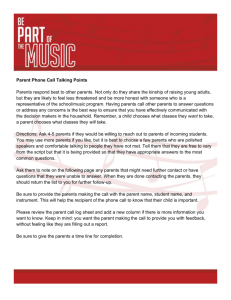
EU Kids Online: written submission to the
COMMITTEE ON THE RIGHTS OF THE CHILD
2014 Day of General Discussion
Digital Media and Children’s Rights
10 August 2014
The EU Kids Online network values the opportunity to contribute to this
important discussion on the rights of the child in a digital age. EU Kids Online is a
multinational research network which seeks to enhance knowledge regarding
European children's online opportunities, risks and safety. It employs multiple
methods to map children's and parents' changing experience of the internet. It also
sustains an active dialogue with national and European policy stakeholders. It has been
funded by the EC’s Better Internet for Kids programme.i
First we note how children’s rights are specifically relevant to the digital age:ii
UN Convention on the Rights of the Child
Their specific relevance in the digital age
Protection against all forms of abuse and neglect
(Art. 19), including sexual exploitation and sexual
abuse (Art. 34), and other forms of exploitation
prejudicial to child’s welfare (Art. 36)
Effort to prevent creation and
distribution of online child abuse
images, sexual grooming, online
dimension of child trafficking
Protection from ‘material injurious to the child’s
well-being’ (Art. 17e), ‘arbitrary or unlawful
interference with his or her privacy, family, or
correspondence, nor to unlawful attacks on his or
her honour and reputation’ (Art.16) and right of
child to preserve his or her identity (Art. 8)
Effort to prevent, manage and raise
awareness of reputational risks, privacy
intrusions, cyberbullying, pornography,
personal data misuse (including
identifying, location-based and financial
information)
Provision to support children’s rights to
recreation and leisure as appropriate to their age
(Art. 31), an education that will support the
development of their full potential (Art. 28) and
prepare them ‘for responsible life in a free
society’ (Art. 29)
Effort to provide educational
technology, online information and
creative resources, and promote digital
skills in an equitable way (taking into
account relevant languages, difficulties
of access or conditions of disability or
disadvantage)
1
Recognizing ‘the important function performed
by the mass media’ encourages provision
of diverse material of social and cultural benefit
to the child (including minorities) to promote
children’s well-being (Art. 17)
Effort to provide public and commercial
educational, civic, science, cultural and
heritage content online in an equitable
way (as above)
Participation rights: ‘In all actions concerning
children… the best interests of the child shall be a
primary consideration’ (Art. 3), including the
right of children to be consulted in all matters
affecting them (Art. 12); see also child’s freedom
of expression (Art. 13) and freedom of association
(Art. 15)
Effort to include all children in diverse
societal processes, including consulting
them on matters of education, research
and ICT governance
EU Kids Online’s evidence is pertinent to the DGD’s two questions.iii
(1) Children’s equal and safe access to digital media and ICT (or, in terms of the
UNCRC articles, children’s rights to protection and provision):
Although public concern over online sexual content is justified, the extent of
children’s exposure should not be exaggerated, and nor should it be assumed that
all children are upset or harmed by such exposure. Evidence suggests that popular
discourses centred on teenage boys’ deliberate exposure to sexual content makes it
harder for parents and others to recognise the distress that inadvertent exposure
may cause girls, younger children and those facing psychological difficulties.
In countries where there is more bullying overall, there tends to be more bullying
online. Given the prior existence of bullying, as more countries gain internet access,
cyberbullying is set to increase. Thus anti-bullying initiatives should accompany
efforts to promote internet use. Further, evidence shows that online and offline
bullying should be seen as connected, part of a vicious cycle in which perpetrators
reach their victims in diverse ways and victims find it hard to escape. In other
words, those who bully may also be vulnerable, and they are often victims
themselves.
It is important to distinguish making new contacts online – a common occurrence –
from going to meet new online contacts offline. It is equally important to recognise
that for the most part, meeting online contacts offline is harmless, probably even
fun. However, for a minority of children, meeting online contacts offline is harmful,
and these children tend already to be the more vulnerable.
Policy makers need to be continually alert to new risks that affect children and
young people, especially arising from peer-to-peer contact. This means that, as well
as conducting representative surveys, qualitative work based on listening to
children is vital to learn what new risks they are experiencing.
2
While younger children have fewer resources to cope with online risk, they are also
more willing to turn to parents for help. Meanwhile, teenagers face particular risks
and they may struggle alone, so they need particular support.
Industry needs to be much more proactive in promoting internet safety awareness
and education. Evidence repeatedly shows that children struggle with user tools,
safety devices, privacy settings and policies, reporting mechanisms. Independent
evaluation of progress by the industry is crucial, to measure whether
improvements have been made (against benchmarks) but more importantly,
whether those improvements work - i.e. are they actually sufficient for children to
manage their safety, privacy, identity and risk online?
Awareness-raising in relation to online risks should be balanced and proportionate,
and targeted at those most at risk of harm. Without being alarmist or sensationalist,
parents need to be alerted to the nature of the risks their children may encounter
online. Awareness-raising should try to encourage dialogue and greater
understanding between parents and children about young people’s online
activities. Increasing parental understanding of risks is particularly important in
those countries where awareness of children’s risk experience is lowest.
(2) Children’s empowerment and engagement through digital media and ICT (or,
in terms of the UNCRC articles, children’s rights to provision and participation):
Children’s online opportunities and skills need human and financial investment.
Not only do younger children and girls not progress as far up the 'ladder of
opportunities' as teenagers and boys, many never reach the more advanced civic,
creative or communicative activities at all. Promoting more creative and skilled
applications is essential to ensure all children avail of online opportunities.
Schools play a pivotal role in digital skills development, mitigating forms of digital
exclusion. However, teachers are often inadequately resourced and trained to carry
out the functions entrusted. Country differences in online skills point to the need
for targeted educational interventions where there is evidence of a digital divide.
Inequalities in digital skills persist – in terms of SES, age, gender and country so
efforts to overcome these are needed.
Encouraging children to do more online will also improve their digital skills as well
as their overall confidence and/or increasing children’s beliefs in their abilities to
use the internet. Similarly, teaching safety skills is likely to improve other skills,
while teaching instrumental and informational skills will also improve safety skills.
Since opportunities and risks online go hand in hand, efforts to increase
opportunities may also increase risks, while efforts to reduce risks may restrict
children’s opportunities. A careful balancing act, which recognises children’s online
experiences ‘in the round’, is vital.
3
A wider analysis of the relation between evidence and policy suggests that:iv
In debates over internet governance, the interests of children figure unevenly, and
evidence shows that only very partial progress has been made in supporting
children’s rights online globally.
The UN Convention on the Rights of the Child is helpful in mapping children’s rights
to provision, protection and participation as they apply online as well as offline.
However, challenges remain.
First, opportunities and risks are positively linked, policy approaches are needed to
resolve the potential conflict between protection on the one hand and provision
and participation on the other (especially as, when such conflicts arise, protection
often wins out over participation).
Second, while parents may be relied on to some degree to balance their child’s
rights and needs, the evidence suggests that some parents are ill-equipped to
manage this (related arguments can be made regarding reliance on schools and
teachers, or other intermediaries such as youth or health workers, many of whom
lack up to date training in digital matters).
Third, resolution is needed regarding the responsibility for implementing digital
rights, since many governments prefer self-regulation in relation to internet
governance, partly for fear of ‘mission creep’ (if the means of protecting children
online spread to forms of censorship).
One solution would be to establish a trusted, efficient global governance body
charged with ensuring the delivery of children’s rights.
Much of the foregoing reflects the European focus of the network’s research. However,
the work of EU Kids Online has also been used to inform UNICEF’s unfolding
global research agenda in relation to children’s rights in a digital age.v There are
some pressing challenges as internet use becomes more global. These include:
The internet is not the cause of problems in children's lives but it certainly
contributes to them. It is increasingly one of the 'places' where problems now occur
(and this means child protection must encompass proprietary, globalised, difficultto-regulate and fast-changing technological platforms and socio-technical
practices).
The affordances of the internet may amplify or otherwise complicate or worsen
existing problems of abuse, violence or exploitation (because the internet enables
rapid circulation of content that is difficult to erase, with little regard to child users
in particular, and very hard to obtain redress).
The internet also offers new ways of advancing positive provision for children,
including opportunities for their greater participation and new pathways to
opportunities to learn and grow. But just as technology is not by itself the problem,
4
nor is it simply the solution. Everything depends on how it is used, by whom, and to
what end.
Since context is all, and context varies worldwide, the effects of internet use vary
globally. To understand the harms and benefits associated with the internet, we
need context-sensitive research and local knowledge, and this is lacking across
much of the world.
Until recently, the internet has been seen as a global north privilege, a symbol of
affluence. But around the world, the global south is going online. This in itself is
resulting in a step change in the number of child users.
Relatedly, evidence shows that what internet use means is changing: (1) internet
access is increasingly mobile first rather than desktop or workplace first, (2) in
many countries there is more community provision than either home or schoolbased provision (both more common in the West, in the early days of the internet),
(3) internet access and content is increasingly commercialised (often with little
local, public or own-language provision), (4) internet access increasingly occurs in
contexts of very low or sometimes-punitive regulation and insufficient mediation
by bodies charged with child welfare or well-being.
Notes
As a major part of its activities, EU Kids Online conducted during 2010 a face-to-face,
in-home survey of over 25,000 9-16 year old internet users and their parents in 25
countries, using a stratified random sample and self-completion methods for sensitive
questions. Now including researchers and stakeholders from 33 countries in Europe
and beyond, the network analyses and updates the evidence base to inform policy. See
www.eukidsonline.net
i
Source: Livingstone, S., and Bulger, M. (in press) A global research agenda for children’s
rights in the digital age. Journal of Children and Media.
ii
For these and related points, see O’Neill, B., Livingstone, S. and McLaughlin, S. (2011)
Final recommendations for policy, methodology and research. LSE, London: EU Kids
Online. [Full text]
iii
Livingstone, S., and O’Neill, B. (2014) Children’s rights online: challenges, dilemmas
and emerging directions. In van der Hof, S., van den Berg, B., and Schermer, B. (eds),
Minding Minors Wandering the Web: Regulating Online Child Safety (pp.19-38). Berlin:
Springer. [Full text]
iv
Livingstone, S., and Bulger, M. (2013) A Global Agenda for Children’s Rights in the
Digital Age: Recommendations for Developing UNICEF's Research Strategy. Florence:
UNICEF Office of Research. [Full text]
v
5









